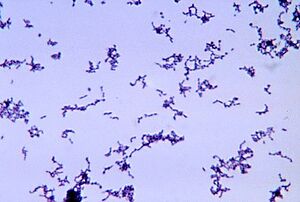Propionibacterium acnes: A Teenager’s Worst Nightmare Defined: Difference between revisions
| Line 1: | Line 1: | ||
=<b>General Background</b>= | |||
==General Background== | ==General Background== | ||
[[Image:Propionibacterium acnes_Image.jpeg|thumb|300px|right|Magnified Magnified Image of <i>Propionibacterium acnes</i>. Photo credit: [http://www.cdc.gov/ CDC.]]] | [[Image:Propionibacterium acnes_Image.jpeg|thumb|300px|right|Magnified Magnified Image of <i>Propionibacterium acnes</i>. Photo credit: [http://www.cdc.gov/ CDC.]]] | ||
<b>By Megan Lydon<br> | <b>By Megan Lydon<br> | ||
Revision as of 18:03, 13 April 2024
General Background
General Background

By Megan Lydon
At right is a sample image insertion. It works for any image uploaded anywhere to MicrobeWiki.
The insertion code consists of:
Double brackets: [[
Filename: PHIL_1181_lores.jpg
Thumbnail status: |thumb|
Pixel size: |300px|
Placement on page: |right|
Legend/credit: Magnified 20,000X, this colorized scanning electron micrograph (SEM) depicts a grouping of methicillin resistant Staphylococcus aureus (MRSA) bacteria. Photo credit: CDC. Every image requires a link to the source.
Closed double brackets: ]]
Other examples:
Bold
Italic
Subscript: H2O
Superscript: Fe3+
Generally P. acnes
Skim Microbiome
Microbiomes, in general, serve a greater purpose than living organisms just existing in their habitat. Through a combination of commensal species of microbes and their interactions with their habitat, environments are formed where the host and bacteria can adapt and regulate processes either to their advantage or negative effects of competition. The skin microbiome works identically. There is mass variability in the skin microbiome. As for microbes involved fungi, bacteria, viruses, and small arthropods contribute to this relationship [1]. In addition, the microbiome is much more complex than once thought. Past research has tended to focus only on pathogens and opportunistic pathogens rather than the entire spread of microbes in general (even “harmless” to human hosts). In addition to the variability of the microbes present in the skin microbiome, locations of the skin and their own environments are also variable from person to person. However, even in these differences, homeostasis between the microbiome and host is imperative for continued healthy interactions on the epithelium and avoids the occurrence of disease.
The skin ecosystem is continuously variable in humidity, temperature, pH, and composition of antimicrobial peptides and lipids [1]. In addition, the frequency of hair follicles can also determine the production of sebaceous materials and eccrine and apocrine glands. With this variety of environments, it establishes a separate niche for microbes to fill and thrive in. The abundance of certain bacteria is dependent on these niches.
Pathogenesis of P. acnes (Acne Vulgeris)
Pathogenesis of P. acnes (Acne Vulgeris)
Public Health Implications
Public Health Implications
Acne Vulgeris Treatments
Acne Vulgeris Treatments
References
- ↑ Jakab, E.; Zbinden, R.; Gubler, J.; Ruef, C.; von Graevenitz, A.; Krause, M. Severe infections caused by Propionibacterium acnes: an underestimated pathogen in late postoperative infections. Yale J. Biol. Med., 1996, 69(6), 477-482. Retrieved April 16, 2024 from https://mail.google.com/mail/u/0/#inbox
Authored for BIOL 238 Microbiology, taught by Joan Slonczewski,at Kenyon College,2024
